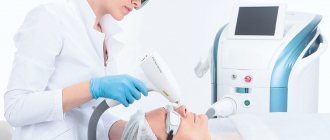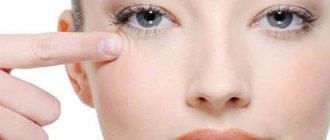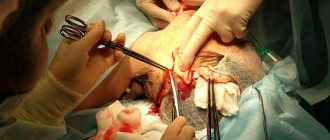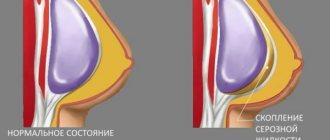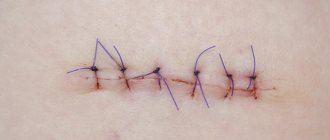Features of scar formation after caesarean section
Caesarean section is a surgical operation in which the fetus and placenta are removed through an incision in the abdominal wall (laparotomy) and uterus (hysterotomy).
Unfortunately, having undergone a vital operation, a woman is also faced with its consequences - aesthetic defects that can cause significant psychological discomfort. These include: the presence of a scar and defiguration - a violation of the contours of the body of varying degrees of severity. The first of these problems is associated with deformations in the area of surgical access, and the second is associated with changes in the skin of the abdomen (thinning, stretch marks, etc.). There are quite a few operational approaches when performing CS, among which the following three are the most common. 1. Inferomedian laparotomy (dissection of the anterior abdominal wall). The incision is made vertically, along the midline between the pubis and the navel. Typically, the length is 12-15 cm. The main advantages of access: speed and convenience. Due to recent circumstances, this access is used mainly in emergency situations, when even a few minutes can be decisive (for example, in case of massive bleeding). 2. Laparotomy according to Joel-Cohen. In this case, a transverse incision is made 2-3 cm below the middle of the distance between the pubis and the navel. It is believed that this is also a fairly convenient and quick surgical access for caesarean section. 3. Pfannenstiel laparotomy. In this case, an arched transverse incision is made along the suprapubic skin fold. In the case of performing an inferior-median laparotomy, patients most often have a reason to contact a plastic surgeon to eliminate undesirable consequences. With this approach, there is a risk of the formation of a coarse hypertrophic postoperative scar (during the first year after surgery) at the site of the surgical access, which is replaced by an atrophic scar, causing significant concern to the patient. The very location of the cut line creates the preconditions for future aesthetic defects. Being in the “moving” zone of the body and in a transverse (in relation to Langer’s lines) position, the so-called. The “joint zone” is in unfavorable conditions. Constant mechanical irritation causes an inflammatory response in the areas of skin surrounding each individual suture. The seam itself is a secondary irritant. This is noticeable by thickening and redness of the skin in the areas where sutures are applied. T.N. “transverse” approaches have the best result due to the fact that mechanical effects (skin tension) are expressed to a much lesser extent. It is precisely this circumstance - the correct choice of the incision site provides the best cosmetic effect and, as a consequence, the popularity of this type of intervention. Both transverse incisions create more favorable conditions for the formation of a postoperative scar (durable and, at the same time, not rough). A longitudinal scar located across Langer's lines will always be rough in the early postoperative period, and in the later stages it will stretch. The best aesthetic result is associated with the Pfannenstiel approach. Being in a skin fold, a thin skin scar merges with it and sometimes becomes completely difficult to distinguish. The severity of developing scar deformities depends on a complex of general and local causes, including the condition of the subcutaneous fat and the degree of tissue tension after suturing the surgical wound.
What are scars
It is the result of the biological process of wound healing. It occurs at the site of deep skin defects when the integrity of the dermis is violated. It is worth considering that the mark from a burn, wound, operation, disease can equally be called a scar. The concepts are almost identical. When massive damage is “tightened,” a new layer is formed, and nature took care to compact the rupture site, increasing the number of cells during regeneration in this particular area. As a result, it is visually significantly different from the surrounding skin.
It is worth considering that successful healing of postoperative scars depends on many factors, as does the restoration of the skin after other injuries. The type of scar and the absence of complications will determine the method of its correction. The stages of regeneration of the epidermis and deeper layers change gradually, and the speed of the next one will depend on how successfully the previous one is completed. That is why, after surgical interventions of any level, so much importance is attached to the postoperative period and professional care until complete recovery. Correction of scar deformities is one of the most difficult tasks in aesthetic medicine. The problem requires an integrated approach using a modern arsenal of hardware and cosmetic products.
Surgical excision of the scar after a caesarean section
Plastic surgery allows you to completely or partially remove the formed formation. Using this method, you can reduce the width of the scar, correct tissue irregularities and remove possible foreign particles from the scar tissue. The wound is sutured with a special thread made of absorbable or non-absorbable material with a neat and invisible suture. The duration of the operation depends on the complexity and size of the scar. It is important to understand that a postoperative scar cannot always be completely excised; in some cases, more than one operation may be required for a perfect result.
Types of scars
Healing is the body's natural reaction that results in the formation of a scar. The faster the primary connection of the edges occurs, provided there is no contamination and suppuration, the more elastic the fusion site will be. It is best if this occurs within 6 hours of the injury. To a large extent, the quality of the overgrowth is determined genetically, but hormonal changes are often the cause. At the same time, cut injuries heal quite easily with minor consequences, crushed or chopped ones take longer, the mark from them is more prominent. If the direction coincides with Langer's lines, then the skin and deep layers are restored quickly and without any special problems in cosmetic terms. For transverse scars, removal of postoperative scars will most likely be required; a specialist will recommend how to get rid of them after one diagnosis of the condition and determination of the type.
Normotrophic
The most invisible and not causing much discomfort. They are on the same level as the rest of the area, have a pale color, and are elastic. Elimination does not require drastic measures; chemical peels will help if therapy is started in a timely manner.
Atrophic
These include stretch marks, stretch marks left after chickenpox and acne marks that form depressions on the skin. They stand out noticeably against the general background and deteriorate the aesthetics of appearance, especially when they are on the face. Because of this, a radical solution to the question of what and how to remove scars and scars from seams on the skin is often required in order to restore attractiveness and eliminate the causes of emotional discomfort.
Anti-age drugs
Bb Laboratories – Hyaluron-elastin-collagen extract
Laennec – solution for injection
Curacen Essence (20 fl x 2 ml)
Two-phase placental serum concentrate
Hypertrophic
As the name suggests, we are talking about the excessive formation of the cellular matrix. It is characterized by a noticeable level of protrusion above the main part of the surface, often has a rich shade, and can remain painful for a long time. Such marks practically do not stretch, which causes additional inconvenience when muscles are tense. Formed after wounds of any etiology, burns, surgery, tattoos and other fairly deep damage to the epidermis.
The peculiarity is that they are limited to the injured area and slowly decrease over the course of several years after the injury; unfortunately, there is no reason to expect them to completely disappear. Often, with a large area, plastic surgery is required and scar removal is quite successful.
Keloid
They are also particularly noticeable; they are formed in the overwhelming majority by certain microdisturbances in the genetic foundations, when any, even minor, damage leads to the formation of coarser tissue at the site of injury. Scars can have different shapes and sizes, but do not coincide with the lines of the surgical incision and even go beyond them.
Another problem is that over time they grow and become denser, causing itching, irritation, and the risk of re-injury, since they do not have elasticity. The irregularities differ sharply from healthy skin; they have a shiny surface with a purple or blue-gray tint. Treatment requires caution and careful choice of method with constant monitoring of the person’s well-being.
Rehabilitation
After the operation, it is necessary to strictly follow the instructions of the attending physician. Violation of the rules of the recovery period can provoke the formation of new scars. The patient should protect the suture line with prophylactic agents that prevent the development of scars (in particular, Mepiform or Dermatix) and use the bandage for the time prescribed by the surgeon.
It is necessary to protect the scar from sunlight for as long as possible, since UV rays can cause persistent hyperpigmentation. After 1.5-2 months, for a better result, the patient may be recommended conservative treatment or other methods used to correct scars.
Stages of scar formation
The resulting wound, no matter what caused it, gradually begins to heal, going through several stages. The process, as a rule, is long, can take from a couple of days for minor damage to the skin, up to six months or more for a large area or depth of penetration. Naturally, the results will be completely different.
I - stage of inflammation and epithelization
Immediately after the incision, swelling occurs and the inflammatory process begins. On the second day, restoration of the integument begins, new capillary vessels are formed. At this time, it is important to ensure that the edges of the wound do not diverge, for which purpose special treatment is carried out with antiseptic agents. Stitches may be required. Over the course of 7-10 days, swelling gradually decreases and granulation tissue forms.
II - formation of a “young” scar
Covers a period of up to a month. Externally, the site of injury becomes loose and pink, which indicates increased blood supply. Collagen-elastin fibers develop, which ensures free stretching of the surface. The risk of seam divergence still remains, so it is important to avoid active loads. The use of healing agents and hardware therapy is recommended. It is worth considering that regeneration slows down with age, which seriously affects the appearance of the restored tissue and its quality.
III - “mature” scar
In the next 3 months, thickening occurs, the skin turns pale, since increased blood circulation, as in the previous stage, is no longer necessary. You can give full load to the muscles of this area, but be very careful about the integrity, excluding re-injury even partially, as this can lead to complications.
IV - stage of final transformation
It will take about a year. The seam turns into a thin light strip, which is practically invisible from the outside. At this stage of healing, treatment and remedies for scars after surgery can already be used, as well as using hardware methods. According to the stage of scarring, specialists conduct a thorough diagnosis and develop an effective plan to restore the aesthetics of the damaged area. It is important to correctly calculate the intensity of the impact and choose methods so as not to cause harm through rash actions. Therefore, it is better to contact only high-class professionals who use registered drugs with effectiveness confirmed by clinical trials, such as CURACEN, created specifically for skin regeneration and rejuvenation.
Let's sum it up
If literally 7-15 years ago the idea of completely eliminating scar tissue was considered unrealistic, then in modern conditions new technologies open up much broader opportunities. It is worth considering that the younger the scar, the faster it can be corrected.
In your daily care, it is important to include products with components whose action is aimed at smoothing the skin surface and building it up, as well as accelerating regeneration processes in the right direction. For example, it could be a silicone dermatological cream that creates an occlusive film, protects against moisture loss and relieves inflammation. There are enough ways and methods to restore beauty; the choice of how to treat, how to reduce and remove scars after surgery is huge. The main thing is not to waste time and contact only a reliable clinic that operates under a license and has experienced specialists on staff with permission to work with modern, highly effective drugs.
How to remove scars on the face: a review of techniques
Having decided what type of scar it is, you can select the optimal correction program, after which it will disappear completely or become so inconspicuous that it will not cause any concern.
Surgical excision
Effective over large affected areas. Results:
- reduction in width;
- elimination of skin relief disorders;
- removal of foreign particles, if they were previously present there.
If you decide to remove surgical scars, be aware that this type of removal is performed under local or general anesthesia.
Chemical peels
A fairly effective way to correct scars when it comes to the early stages of formation. Surface options are especially recommended. In this case, several types of acids are used in different concentrations, the frequency of use is approximately every 6 days, the timing and dosages are adjusted taking into account individual characteristics. Next comes the stage of stimulating natural recovery, which produces a defibrosing effect that improves the general condition of adjacent, undamaged tissues.
Medium peels
Trichloroacetic acid is used in combination with citric and ascorbic acid. Not only the upper stratum corneum is removed, but the deeper layers are also affected. This is a rather serious, traumatic and painful procedure, but the effectiveness is much higher than with superficial exposure.
Fractional photothermolysis
Reduces the area of scars, making them elastic, unnoticeable, and as close as possible in appearance to healthy skin. In essence, this is a temperature effect on tissue. In contact with the surface of the epidermis, the laser beam, divided into fractions, affects only problem points. The technology appeared in 2004 and has proven its effectiveness and safety for health.
Laser correction
When considering options for how to get rid of scars after surgery, removing them using the hardware method is becoming increasingly popular. It is carried out under sterile conditions by a highly qualified specialist. By forming microzones of damage, it stimulates cell activation to restore the affected area in accordance with the natural program. Used to eliminate almost all types of scars.
Mesotherapy
The technique has been popular for more than 50 years and has been successfully implemented in various fields of medicine and cosmetology. Used for shallow injuries, carried out using the injection method. Drugs that have a softening and smoothing effect are introduced. Often used as part of complex therapy in combination with other methods of smoothing formations on the skin. Particularly relevant for the area around the eyes, nasolabial triangle. It is recommended after blepharoplasty, has a normalizing effect on tissue healing, and reduces external signs of aging.
Plasmolifting
Often, for those who do not know what to do and how to remove a scar after surgery effectively and quickly, this method is offered, since it does not cause rejection by the body and is quite effective. It consists of isolating plasma from the patient’s blood in a special centrifuge and administering it, stimulating the growth of new cellular structures, causing acceleration of metabolism and regeneration processes. After 2-3 procedures there is a noticeable improvement.
Dermabrasion
This is the name of mechanical resurfacing; it is used to remove the top layer of the epidermis with part of the scar. The manipulation is performed by dermatologists or plastic surgeons using a special apparatus. To achieve an ideal result, a course of several sessions is required. The method is especially effective for eliminating protruding scars. Renewed skin looks younger and softer.
Super thin injection needles Nanoneedle
Curacen Essence (20 fl x 2 ml)
Nanoneedles with ultra-thin walls 30G
Nanoneedles with ultra-thin walls 33G
Nanoneedles with ultra-thin walls 34G
Kurasen in correction
Injection methods for eliminating cosmetic defects in appearance are not inferior to surgical ones, and in some cases even give better results with a more modest number of contraindications to the use of drugs, in contrast to hardware methods. CURACEN has no analogues in terms of effectiveness and safety, thanks to the unique combination of natural components. Developed by Japan Bio Products scientists for rejuvenation and accelerated regeneration of the epidermis. The RHANA medical corporation, which is the official representative in the Russian Federation, guarantees quality. It can only be used by specialists with appropriate medical education.
As a rule, when discussing how to quickly remove scars on the face in cosmetology, the drug is injected directly into the affected area to normalize the processes of collagen formation. The basis for its use is the presence in its composition of regulatory components with high biological compatibility.
As a result, the seals become softer and more elastic, since disturbances at the molecular and biochemical levels are eliminated, and their own regeneration mechanisms are restored. A course of Curasen injections allows you to effectively influence processes associated with impaired dermal remodeling in patients after blepharoplasty and other plastic and clinical surgery procedures in the cervicofacial part. It also showed excellent results in removing scars in combination with the above methods, complementing and enhancing the final result.
According to experts in the field of dermatology and cosmetology, the drug is recommended not only for the correction of scars, but also for:
- smoothing out superficial wrinkles;
- excessive pigmentation;
- photodamage,
- flabbiness and dryness.
As a result of using CURACEN with a natural complex of biological active components for complex restoration and regeneration of the dermis, a general improvement in the condition and noticeable rejuvenation with a sustainable long-term effect is observed.
